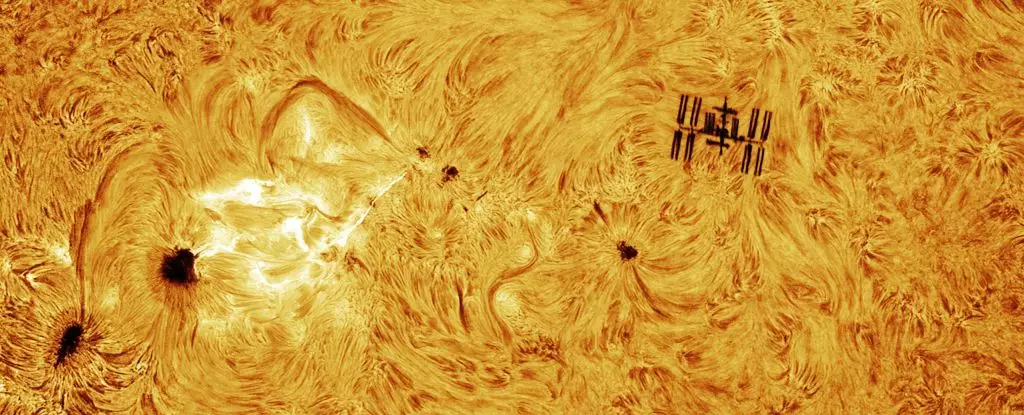Astrophotography often demands a marriage of technical skill, patience, and an uncanny stroke of luck. Arizona-based astrophotographer Andrew McCarthy recently demonstrated this perfectly when he captured an extraordinary image of the International Space Station (ISS) passing in front of the Sun — but with an electrifying twist: a medium-sized solar flare erupted in the same frame. This rare convergence of human technology and natural cosmic fireworks resulted in a photograph that transcends typical space imagery, inviting us to reconsider both the challenges and beauty of capturing fleeting moments in the heavens.
The significance of this photograph lies not only in the difficulty of timing the ISS transit—a celestial event lasting only fractions of a second—but also in its simultaneous capture of a dynamic and ephemeral solar flare. Solar flares are bursts of intense radiation caused by sudden releases of magnetic energy on the Sun’s surface. Their fleeting existence, often measured in minutes, makes them notoriously difficult to photograph. McCarthy’s ability to frame the ISS transit along with this volatile solar phenomenon is a technical and artistic feat that few have managed.
The Intersection of Human Engineering and Solar Majesty
The ISS, orbiting approximately 400 kilometers above Earth, is a symbol of human achievement and international cooperation in space exploration. Meanwhile, the Sun remains a primal force, its solar flares revealing the volatile nature of stellar dynamics. McCarthy’s photograph symbolically juxtaposes these two forces: humanity’s engineered marvel and the raw power of our nearest star.
Despite the dramatic flare, the ISS remains unaffected due to its relatively modest Earth orbit range. However, capturing a solar flare alongside the ISS transit raises awareness of the hazards astronauts face from solar radiation, such as increased exposure during such eruptions. It’s a compelling reminder that while humanity has pushed its presence beyond Earth’s surface, the cosmic environment remains challenging and unpredictable.
Astrophotography as a Fusion of Art and Science
Andrew McCarthy’s approach to astrophotography reflects an advanced blend of scientific understanding and artistic ambition. His technique relies on capturing tens of thousands of individual frames that are assembled into a composite image — a process that reveals details imperceptible to the naked eye. In the Arizona desert heat, his creative solutions included cooling his telescopes with ice packs and coolers to maintain image quality, a testament to the demanding conditions astrophotographers often endure to chase these moments.
His final image, a composite mosaic, extends beyond simply recording an ISS transit; it offers a detailed portrayal of the full solar disc, with elements borrowed from the 2024 solar eclipse enhancing the dramatic contrast between the chromosphere and the black background. This is not just an image but a visual narrative of the Sun’s dynamic surface and the fleeting nature of cosmic events.
“Kardashev Dreams”: Charting Humanity’s Cosmic Aspirations
McCarthy titled his image “Kardashev Dreams,” citing the Soviet astrophysicist Nikolai Kardashev, who proposed the Kardashev Scale — a method of measuring a civilization’s technological advancement based on energy consumption. The naming signals a hopeful vision that humanity’s current explorations and technological feats are the first steps toward greater cosmic capabilities.
This image acts as a metaphor for the delicate balance between our ambitions and the vast, unpredictable universe we seek to understand. It reminds us that mastery over our environment on a cosmic scale will require continued innovation, resilience, and awe of the natural phenomena that surround us.
Guiding Others to Capture the Sky’s Fleeting Moments
For amateur and professional astrophotographers eager to chase these transient transits, tools such as Transit Finder can pinpoint when the ISS will cross in front of the Sun or Moon. The endeavor combines precise timing, advanced optics, and ideal weather conditions, underscoring the dedication required to capture what amounts to a fleeting cosmic shadow against a blazing backdrop.
McCarthy’s achievement strikes a chord beyond photography; it illustrates how patience, creativity, and technical expertise can transform ephemeral, complex celestial dances into lasting, inspirational art. As we continue to explore our solar system and beyond, such images celebrate not only what we can observe, but also what we dare to imagine.

